SantiagoSantiago de Chile established on both banks
of the Mapocho River is located on a beautiful
valley at the foot of the Santa Lucía
Hill, between the Cordillera de la Costa
range and the Andes. The fifth largest city
in South America, it is a city of contrasts
between modern and old architecture. Santiago
is the central point of the long, thin country
of Chile.
The Mapuche destroyed it in 1541, only six
months after Pedro de Valdivia founded it,
but soon the Spanish were back and building
it up again. Today, it is home to nearly
5 million inhabitants--over a third of all
Chileans. There were celebrations and
banners celebrating 469 years since their
formation.
Only 60 km away are the main South American
ski centers, and the beaches of the Pacific
are only an hour's drive to the northwest.
Just south of Santiago lie the vineyards
of the Maipo Valley. Nearby are hot springs
centres and placid haciendas dating back
to the 17th Century.
The main road - Avenida Libertador Bernardo
O'Higgins (known to Santiagans as the
Alameda) is a 5km avenue running through
the centre of Santiago. At the heart of Santiago
is the Plaza de Armas. which is surrounded
by the Metropolitan Cathedral and other historical
buildings. Santa Lucia is the hill upon which the Spanish
founded Santiago in 1541. It is a lone steep
rock, with many plants and an antique building
rising steeply from the city below.
The Museum Columbia just off the main Place
de Armes houses an interesting collection
of artefacts mainly from western South America.
The city's European heritage is evident
in the Parque Forestal, designed by a French
landscaper on the model of Parisian parks.
Walkers pass down tree-lined paths along
the Mapocho, past small squares and the Museo
de Bellas Artes. The Mercado Central is of
British design, with wrought-iron ceiling
parts that were imported from England in
the mid 19th century.
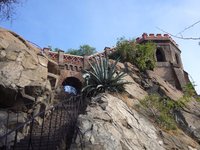 |
| Santa Lucia Park |
|
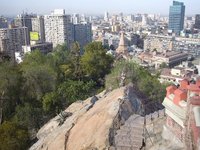 |
| View from Santa Lucia Park |
|
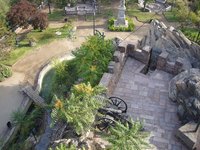 |
| View from the tower |
|
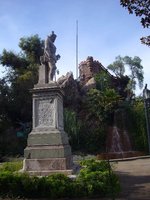 |
| Pedro de Valdivia |
|
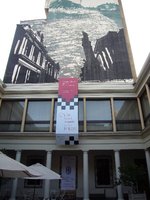 |
| Museum Columbia |
|
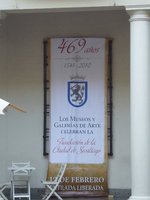 |
| Celebrating 469 years of Chile |
|
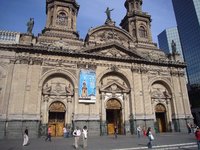 |
| Cathedral |
|
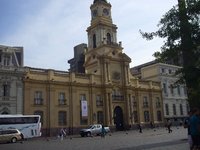 |
| Building on Plaza de Armes |
|
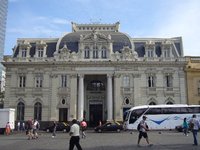 |
| Building on Plaza de Armes |
|
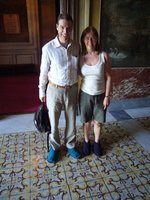 |
| Large slippers - Cousaino Museum |
|
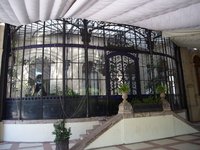 |
| Conservatory at Cousaino House |
|
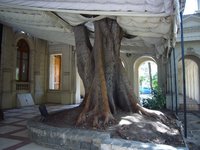 |
| Large tree! |
|
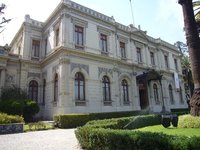 |
| Cousaino House |
|
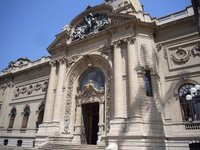 |
| Museum of Belle Arts |
|
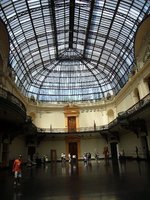 |
| Museum ceiling |
|
Bellavista
Across the river, the Bellavista neighborhood
is home to many restaurants and cafes. Stunning
views of the city can be seen from the top
of Cerro San Cristòbal, accessible
by bus, funicular, or by a vigorous hike.
Also in the Bellavista area is La Chascona,
the house designed by Nobel-Prize-winning
poet Pablo Neruda -whose work recently gained
popularity in the film ‘Il Postino’.
Pueblito Los Dominicos
Los Dominicos began as an artists' commune
supported by the Dominican monestary within
which the market resides – with more
than 150 workshops you will find the most
complete and representative sample of chilean
handcrafts. In the centre of the commune
was a cage of many types of chicken - all
for sale.
Maipo Valley Vineyards
We travelled south to the Maipo river valley,
where the largest and most important Chilean
vineyard was founded: Concha y Toro. This
area is ideal for the production of the Cabernet
Sauvignon grapes that are used to produce
the most traditional red wine of the country.
Founded in 1884, this vineyard uses the most
modern technology for its refrigeration equipment,
stainless steel tanks, filters, and casks
made of American and French oak. We visited
the private park of the family, the historical
museum and the cellars and the caves, where
amongst others the legendary “Casillero
del Diablo” (Cellar of Devil) is. This
was so called because the owner was tired
of people taking his wines so he stored it
in the deepest and darkest cellar and made
up a story about a phantom devil so that
no one would dare go in there.
Red wines include Cabernet Sauvignon, Merlot
and carmeniere - the grapes were introduced
in the early 1980 from France. The carmeniere
grape was killed by disease in France so
Chile now produces the majority of carmeniere
wines in the world. White wines are predominantly
Chardonnay and Sauvignon blanc. Chile is
now the firth largest exporter of wines and
the ninth largest producer.